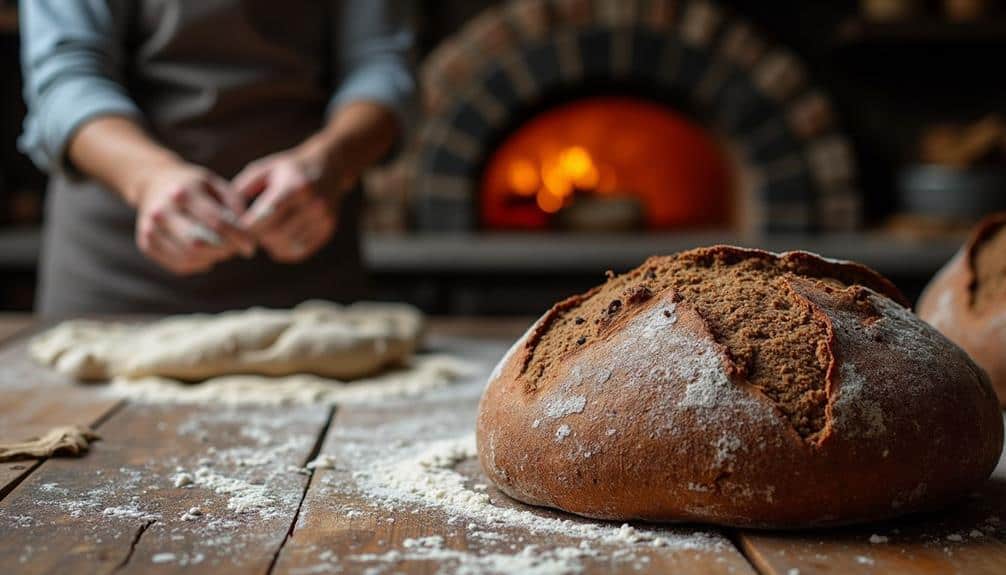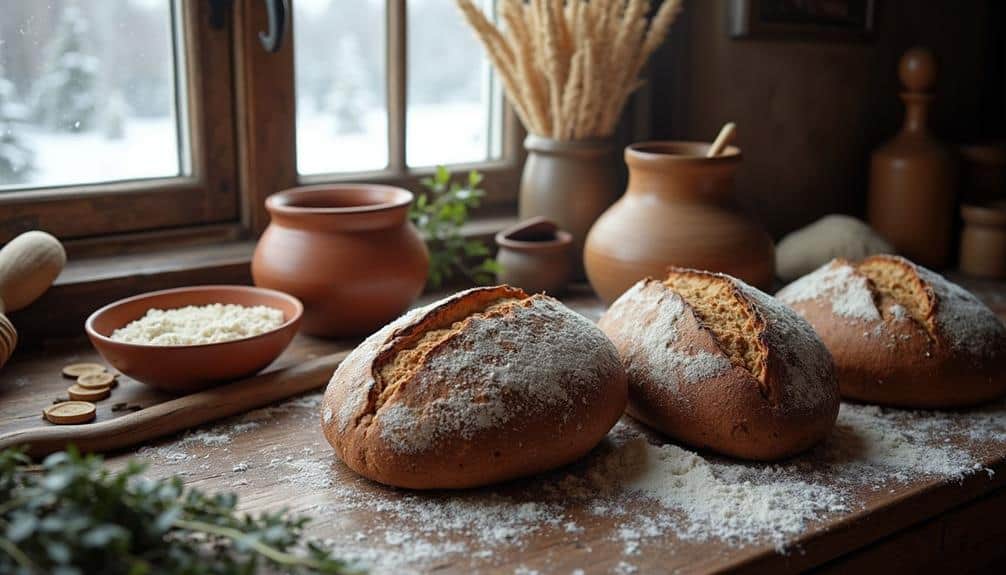Authentic Russian black bread, with its roots deep in the 11th century, is more than just a staple; it embodies the resilience and hospitality of Russian culture. Crafted primarily from whole rye flour and a sourdough starter, this bread is known for its dense texture and distinctive flavor. The traditional baking methods, which include low-temperature baking, create a dark crust and robust taste unique to this bread. Its rich history, from sustaining people during the Siege of Leningrad to its continued prominence today, reveals much about its enduring importance. What secrets lie in its time-honored techniques and regional variations?
Origins and Cultural Significance

Russian black bread, a staple with deep historical roots, holds significant cultural importance in Russian society. This distinctive bread has been a dietary mainstay since the 11th century, when rye, the primary grain used, became widespread in the region. Its resilient nature allowed it to thrive in Russia’s harsh climate, ensuring food security for centuries.
Cultural rituals surrounding Russian black bread are profound. It is often associated with the concept of hospitality. In many traditional households, a loaf of black bread is offered to guests as a symbol of welcome and respect. This practice extends to various significant life events, such as weddings and religious ceremonies, where black bread’s presence signifies prosperity and communal unity.
Historical anecdotes further enrich its significance. During World War II’s Siege of Leningrad, black bread was a lifeline. A rationed piece was often the difference between survival and starvation, embedding it deeply into the collective memory of those who endured the hardships.
These cultural rituals and historical anecdotes underscore black bread’s integral role in Russian life. It is not merely a food item but a vessel of tradition and resilience, reflecting the enduring spirit of the Russian people across generations.
Traditional Ingredients
Understanding the cultural and historical significance of Russian black bread naturally leads to an exploration of its traditional ingredients. Central to this iconic bread is rye flour, which imparts its characteristic dark color and robust, slightly tangy flavor. Rye, a hardy grain, thrives in the colder climates of Russia, making it a staple in Russian baking for centuries.
The use of rye flour not only contributes to the bread’s dense texture but also endows it with a higher nutritional profile compared to wheat-based breads, offering more fiber and essential nutrients.
Another essential ingredient in authentic Russian black bread is the sourdough starter. This natural leavening agent, cultivated from wild yeast and lactic acid bacteria, is responsible for the bread’s distinct sourness and complex flavor profile.
The process of maintaining and utilizing a sourdough starter is both an art and a science, requiring patience and skill. Unlike commercial yeast, a sourdough starter enhances the bread’s digestibility and shelf life while also contributing to its chewy crumb.
Additional ingredients may include molasses or malt for sweetness, caraway seeds for a hint of spice, and salt to balance the flavors, all culminating in a rich, hearty loaf emblematic of Russian culinary tradition.
| Ingredients | Instructions |
|---|---|
| For the Sponge: | 1. In a large bowl, combine the sponge ingredients. Cover and let stand at room temperature for 8-12 hours until bubbly and doubled in volume. |
| – 1 cup rye flour | |
| – 1 cup warm water (110°F) | |
| – 1 teaspoon instant yeast | |
| For the Dough: | 2. In a medium saucepan, heat the milk, molasses, butter, and salt just until warm and butter is melted. Remove from heat and let cool to lukewarm. |
| – 1 cup warm milk | |
| – 1/4 cup molasses | |
| – 2 tablespoons unsalted butter | |
| – 1 1/2 teaspoons salt | |
| – 1 1/2 cups bread flour | |
| – 1 1/2 cups rye flour | |
| – 2 tablespoons unsweetened cocoa powder | |
| – 1 teaspoon instant espresso powder | |
| – 1 tablespoon caraway seeds | |
| – Additional bread flour as needed | |
| 3. In a large bowl, combine the sponge, milk mixture, and 1 cup bread flour. Beat on medium speed for 2 minutes. | |
| 4. Stir in the rye flour, cocoa powder, espresso powder, caraway seeds, and enough remaining bread flour to form a soft dough. | |
| 5. Turn dough onto a lightly floured surface and knead for 6-8 minutes until smooth and elastic, adding more flour as needed to prevent sticking. | |
| 6. Place dough in a greased bowl, turning once to grease top. Cover and let rise in a warm place for 1 hour. | |
| 7. Punch down dough. Shape into a round loaf and place in a greased 9-inch round baking pan. Cover and let rise for 30 minutes. | |
| 8. Preheat oven to 375°F. | |
| 9. Bake for 30-35 minutes until deep brown. Remove from pan and let cool completely on a wire rack before slicing. |
Unique Baking Techniques

Crafting authentic Russian black bread involves a series of unique baking techniques that distinguish it from other types of bread. Central to this process is the use of sourdough fermentation, a traditional method that not only imparts a distinctive tangy flavor but also enhances the bread’s texture and shelf life.
Unlike wheat-based breads, Russian black bread relies heavily on rye flour, which contributes to its dense and hearty structure. The sourdough starter, often cultivated over several days, forms the foundation of the dough. This starter is a living culture of wild yeast and lactic acid bacteria, which work together to ferment the rye flour.
The fermentation process is slower than that of yeasted breads, allowing for the development of complex flavors and improved digestibility. The dough is typically mixed and rested multiple times to guarantee even hydration and fermentation.
Baking is performed at a lower temperature over a longer period, which helps to achieve the characteristic dark crust and moist crumb. The use of steam during baking is another critical element, as it prevents the crust from hardening too quickly, allowing the bread to expand fully and develop its unique texture.
Regional Variations
Numerous regional variations of Russian black bread showcase the diversity in ingredients and techniques that reflect the local flavors and traditions.
In the heart of Russia, Moscow variations tend to emphasize a denser texture and a robust flavor profile. These breads often incorporate a greater amount of rye flour and a natural sourdough starter, which gives them a distinctive tang. The use of malt and molasses in Moscow’s black bread recipes contributes to its deep, dark color and slightly sweet undertone, distinguishing it from other regional versions.
Moving to the colder climes, Siberian recipes highlight the resourcefulness of the inhabitants of this vast region. Due to the harsh weather conditions and limited access to diverse ingredients, Siberian black bread often incorporates more resilient grains such as buckwheat.
The inclusion of these grains not only adds nutritional value but also imparts a unique earthy flavor. Additionally, Siberian bakers frequently use a longer fermentation process to enhance the bread’s flavor and shelf life, essential for survival in remote areas.
These regional variations underscore the adaptability and richness of Russian black bread, making it a symbol of cultural heritage and local ingenuity.
Health Benefits

The rich tapestry of regional variations in Russian black bread not only reflects cultural diversity but also contributes to its array of health benefits. Central to its appeal is its impressive nutritional profile. Made primarily from rye flour, this bread is rich in dietary fiber, essential vitamins, and minerals such as iron, magnesium, and B vitamins. These nutrients are vital for maintaining overall health and wellness, offering a balanced source of energy with a lower glycemic index compared to white bread.
One of the most significant health benefits of Russian black bread is its impact on digestive health. The high fiber content aids in promoting regular bowel movements and preventing constipation, thereby supporting a healthy digestive system.
Additionally, the fermentation process involved in making this bread often includes the use of sourdough starters, which introduce beneficial probiotics. These probiotics can enhance gut flora, contributing to improved digestion and immunity.
Moreover, the dense structure and rich flavor of Russian black bread encourage slower eating, which can aid in better digestion and greater satiety, helping to manage weight effectively.
Modern Interpretations
In recent years, modern interpretations of Russian black bread have emerged, blending tradition with contemporary culinary techniques. These adaptations cater to evolving dietary preferences and nutritional awareness.
One prominent innovation is the use of sourdough adaptations, which enhance the bread’s flavor and digestibility. Sourdough starter, rich in natural yeasts and beneficial bacteria, not only imparts a nuanced tanginess but also improves the texture, making the bread lighter and airier compared to its traditional dense form.
Another significant trend is the development of gluten-free options, addressing the increasing demand from individuals with gluten sensitivities or celiac disease. These variations often incorporate alternative flours such as buckwheat, sorghum, or teff, which mimic the dark, rich qualities of traditional black bread while ensuring it is safe for those with dietary restrictions.
The challenge lies in maintaining the characteristic texture and flavor, but advancements in gluten-free baking techniques have made it possible to create satisfying alternatives.
Tips for Home Bakers

Building on the innovative approaches to Russian black bread, home bakers can experiment with these modern techniques to create their own variations. Precision is key, and having the right baking tools, such as a digital scale, guarantees accurate measurements for consistency.
A stand mixer with a dough hook attachment can greatly ease the kneading process, guaranteeing even gluten development for a better crumb structure.
Understanding fermentation methods is essential for achieving the bread’s distinctive flavor. Employ a long, slow fermentation by using a sourdough starter, which not only enhances the taste but also improves the bread’s keeping qualities.
Maintaining the correct temperature during fermentation is critical; aim for a cool environment, around 70°F, to allow flavors to develop fully.
Incorporate whole rye flour as the primary ingredient, as its high fiber content and robust flavor are characteristic of traditional black bread.
Consider adding molasses or dark honey to replicate the authentic sweetness. For a rustic touch, bake in a cast iron Dutch oven to mimic the effects of a traditional Russian clay oven, which helps retain moisture and create a superior crust.
With these tips, home bakers can master the art of creating authentic Russian black bread.




